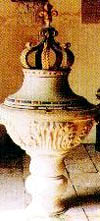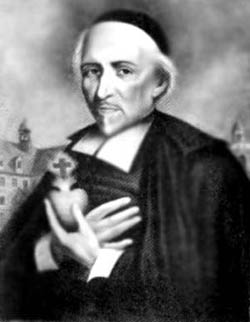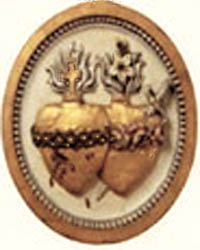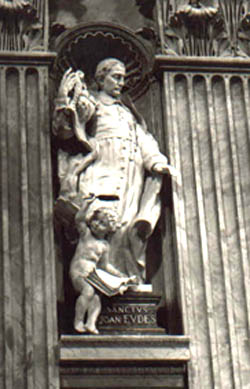Prof. Plinio Correa de Oliveira
Please enjoy this "Saint of the Day" article from Plinio. May we implore the Immaculate Heart and stay close to the Sacred Heart of Christ by staying in the heart and mind of the Church. St. John Eudes, ora pro nobis!
Biographical selection:
 The font where St. John Eudes was baptized |
He left the Jesuits to enter the Congregation of the Oratory, founded by the famous Fr. Pierre de Berulle, who worked to re-establish orthodoxy of doctrine and sanctity of life among the clergy. St. John Eudes thought that the training of priests should also be a priority, so in 1643, he left the Oratory and founded the Society of Jesus and Mary (the Eudists Fathers) to specialize in seminary education. Its first seminary opened in Caen, shortly followed by many others.
In order to convert women of ill-fame and assist those who had converted from a wayward life, he founded another institution, the Congregation of Our Lady of Charity. He also instituted the parish mission to evangelize the neglected souls. For long years, he preached to large crowds in churches or the open fields, or in the courts of nobles and the King. His sermons were known for his strong condemnation of the vices of his audience and their great eloquence supported by his eminent sanctity.
He spread the devotion to the Sacred Hearts of Jesus and Mary, and was responsible for getting the church to accept liturgical offices in its honor. Always faithful to the Chair of Peter, he was persecuted by the Jansenists, whom he counter-attacked with energy.
He died August 19, 1680, pronouncing the names of Jesus and Mary.
Comments of Prof. Plinio:
There is a parallel between the spiritual and the juridical work developed by St. John Eudes during his lifetime.
 St. John Eudes |
The country at that time was suffering a profound religious crisis from which the French Revolution was born. This religious crisis had its substance in the fact that love of God and true fervor had almost disappeared in the souls of the people, and the Catholic sense of the faithful had dimmed.
Divine Providence, wanting to avoid the coming tragedy of the French Revolution and, above all, the apostasy that it represented, called great souls in different ways to reignite Catholic fervor in France. Many saints of the 17th and 18th centuries were zealous and fiery souls. They were not characteristically great theologians, but saints whose role was to spread the love of God and stoke the coals that still smoked and fan them into burning flames.
Among such souls, you have St. Vincent de Paul who was a man with an incandescent love of God and St. Francis of Sales who spread a profound love of God in the highest levels of society. But, in particular, there were two fundamental burning fires at that time:
• The work of St. Louis Grignion de Monfort in the 18th century in the Vendée and Bretagne, which gave birth to the Chouannerie;Anyone who reads the revelations of St. Margaret Mary Alacoque sees that the goal of those apparitions was to inaugurate devotion to the Sacred Heart of Jesus. One of its main characteristics was to move tepid Catholics out of their their tepidity, to light the love of God in souls that had cooled. St. Margaret Mary received that devotion as a great treasure, but she was a Visitation religious who could not leave her convent. Her mission was to record the devotion, practice it, and become a saint. Her canonization was a confirmation and approval of the Church for that devotion.
• and the work of St. John Eudes, which we are commenting on now.
 The Sacred Hearts of Jesus and Mary |
St. Margaret Mary also wrote to missionary priests to make them aware of the devotion, and it began to spread in pious circles. One of those who heard about it was St. John Eudes, who soon after embarked on his great work as the apostle of the devotion to the Sacred Hearts of Jesus and Mary.
A great orator, he founded a new congregation hoping that, with the prestige of his sanctity and the work of that institution, the devotion would take off in France. But this did not happen. There was another refusal of grace. This time it was not the refusal of the King, but the hardness of heart of the French people. The devotion made little impression and did not raise great enthusiasm. The writings of John Eudes, who became a saint, formed the basis for a generalized devotion to the Sacred Hearts in the 19th century, but the 18th century did not accept that devotion. He was a kind of rejected prophet who fought with all his strength unsuccessfully against the tepidity of the French Catholics.
 St. John Eudes in St. Peter's Basilica, the Vatican |
You see, then, a saint who fought against tepidity in two ways: spiritually, by founding a congregation destined to spread this devotion; and juridically, by founding a new way of teaching and forming the clergy that existed in thesis, but was not yet a fact in France.
What does the life of St. John Eudes teach us? I think that one of the most dangerous things for a counter-revolutionary is to become mediocre and tepid. To become a person who no longer cares about the great panoramas and the grand needs of our cause, but one who just wants to live his petty life with its small pleasures. In many ways, this is more dangerous than depraved movies, immoral magazines, and bad company, because it corrodes the very core of the love of God in a soul. Such a spirit of mediocrity and tepidity makes a person insensible to the Passion of the Church in our days and the grandeur of the fight to save the Church from her enemies. No Lepanto, no Covadonga, just the small pleasures of the little life of self.
The devotion to the Sacred Hearts of Jesus and Mary is an adequate means to correct such a spirit. If we have this problem, or even this temptation, we should pray to the Sacred Hearts of Jesus and Mary to restore us to fervor. It is the specific remedy for such a serious illness. We should also ask the patronage of St. John Eudes to achieve this objective.
